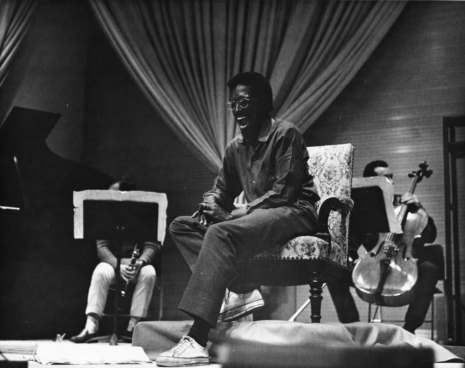_465_465_int.jpg)
One day at the record store I saw a used copy for sale of Sir Peter Maxwell Davies’ Eight Songs for a Mad King and I bought it and took it home. I had gotten interested in the work of minimalist composer Julius Eastman and I knew that he’d sung what I’d read described as basically a weird opera, but I was otherwise unfamiliar with the piece.
The title was intriguing. What would something titled Eight Songs for a Mad King sound like? I was about to find out.
The first time I played the record, I’ll confess, it left me rather puzzled. It’s a difficult listen. I frankly didn’t know what to make of it, but one thing seemed certain, there’s nothing else even remotely similar to Eight Songs for a Mad King in modern classical music. Actually it’s not quite an opera, technically it is musical theater, a monodrama, with just one vocalist. Peter Maxwell Davies—then the enfant terrible of avant garde composers—was inspired to write the score expressly for the extended vocal range of South African actor (and world renowned vocal coach) Roy Hart and indeed the piece takes full advantage of a baritone with a five octave range. The music was arranged for six players on flute/piccolo, clarinet, percussion, piano/harpsichord, and violin/cello.
The “mad king” of the title is King George III, who suffered from acute mental illness. During his rule, George III became seriously deranged, speaking nonstop for several hours until he was foaming at the mouth and constantly repeating himself. He was delusional and hallucinated. It was claimed that the psychotic sovereign once mistook a tree for the King of Prussia. In his later years, the King tried to teach his bullfinches to sing and the players (minus the percussionist who represents the King’s handler) portray these birds musically and enact a dialogue of sorts with the insane monarch. The songs heard in the piece are actually based on the music played by a still extant miniature mechanical organ that was owned by George III that he employed to train his birds. There are snatches of Handel’s Messiah—a favorite of George III—heard during the score. The libretto was written by Randolph Stow and is derived from the words of George III. It takes the form of eight monologues delivered by the King to his bullfinches.
Eight Songs for a Mad King premiered on April 22, 1969 at the Queen Elizabeth Hall in London with Hart in the lead and although it was generally well-received by the audience—which included a 22-year-old David Bowie—there were smatterings of boos, heckling and several walkouts. There is little doubt that the members of the audience had never seen or heard anything like this. Peter Brooks’ Marat/Sade is the only thing even remotely comparable, but musically that play is still somewhat conventional. Hell, Captain Beefheart or the Residents sound conventional compared to Davies’ representation of the drooling mad monarch. This is not classical music for the faint of heart. The timid listener need not bother.

Julius Eastman rehearsing ‘Eight Songs for a Mad King.”
Listening to Julius Eastman perform the work on the studio recording (which was presumably paid for by director Ken Russell, who hired Davies to score his controversial film The Devils) is oddly impressive, but without the visuals it’s ultimately just confusing. Admittedly it wasn’t until I saw the YouTube video of the extraordinary 2013 staging of Eight Songs with Welsh singer Kelvin Thomas—who incredibly was 92 years old at the time of the performance—that I fully “got” what was happening dramatically. It makes more sense if you know that the musicians on stage were performing from inside of giant bird cages, or if you can see the King flailing around in his nightshirt and acting crazy. The Eastman performance heard on record is brave and remarkable, but there’s not enough context to experience it as anything other than someone with highly developed vocal cords making weird noises while a small chamber ensemble makes a racket. It’s not something many people would choose to listen to for pleasure, no, but as a theatrical performance it’s something else entirely.
Have a listen to a bit of the Julius Eastman version, which saw him nominated for a Grammy award. As an audio only experience, I think the reader will agree with me that it is a bit difficult to make sense of this minus the visual aspects.
And here is a well-shot live performance by Kelvin Thomas as the mad King supported by the Psappha Ensemble—a group of musicians closely affiliated with Sir Peter Maxwell Davies, who died in 2016—in director Michael McCarthy’s 2013 revival for Music Theatre Wales.
A YouTube commenter named Kevin Wang had this to say:
“I’m a musician suffering from schizophrenia, and I can say that at least for me, this work does remind me of what I often hear inside my head. I don’t think this is “making fun of” people with mental disorders; rather, I think this could be a means for “ordinary” people to sort of understand why mental disorders can be so tormenting and debilitating for those who need to deal with them every day.”
Kelvin Thomas’ superb portrayal of King George III in the 2013 staging of ‘Eight Songs for a Mad King.’
Above, vocalist Kelvin Thomas and director Michael McCarthy discuss their revival of ‘Eight Songs for a Mad King.’